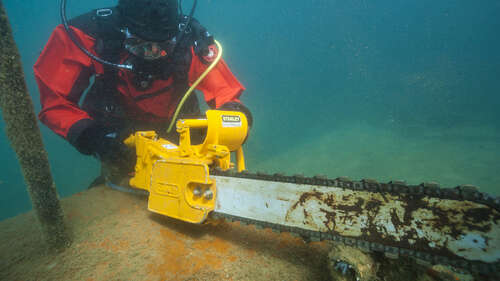
Underwater chainsaws are hydraulic powertools that use compressed air to rotate a bladed chain. As with regular chainsaws, that chain is affixed with blades to cut through wood, and some can even handle concrete, metal, and plastic. They don’t always have the same rip-roaring power or portability as gas-powered chainsaws, but they’re invaluable for underwater applications. Their waterproof encasings are better equipped for wet conditions, so they also serve well in the mud and rain. Some models even have diamond-grit teeth to prevent kick-backs and jams when you’re slicing away at extra-hard materials.
Underwater chainsaws are primarily used for cutting the wooden pilings of docks, bridges, and other submerged structures. It sounds niche, but it’s actually quite common. The water is a strong catalyst for rotting wood and eroding docks, so constant maintenance is critical.
To use an underwater chainsaw, all you need is a compatible air compressor and a hose to hook it up. Most standard air compressors will do, but diesel-powered compressors are usually more portable compared to electric ones. Many underwater chainsaws have extra safety features. For example, they often have cooling systems, powered by either water or oil. Options with hand guards and chain brakes prevent broken chains from taking off a hand. Furthermore, you can expect interlocking safety triggers to help minimize accidents.
[Featured image by US Navy via Wikimedia Commons | Cropped | Public Domain by Title 17 of the US Code]

